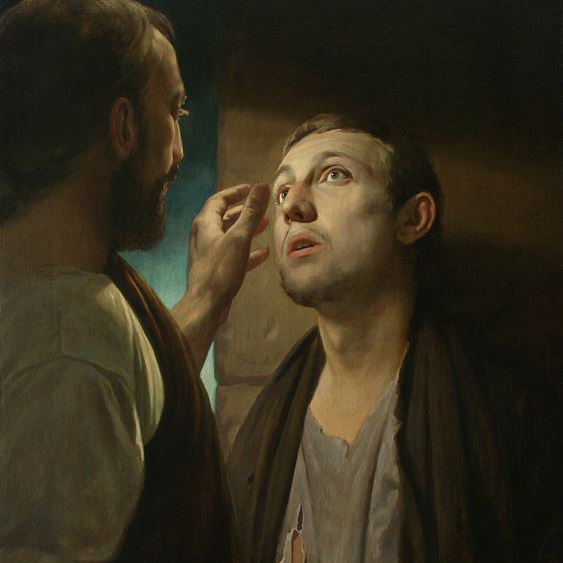The Holy Spirit and the Ministries of Jesus
The same Holy Spirit that descends on Jesus as he is being baptized by John in the Jordan River had been actively involved in his conception, birth, and growth. The Spirit also influenced the lives of Jesus’ family and those who eagerly awaited Jesus’ coming. Zechariah and Elizabeth, well along in years and childless, had been enabled to bear a son who would be filled with the Holy Spirit from birth (Luke 1:15). When Gabriel tells Mary that she will bear a son named Jesus who will be called the Son of the Most High and will reign on David’s throne, she asks how this could happen, since she is a virgin. The angel tells her that the Holy Spirit will come on her and the power of the Most High will overshadow her, so the holy one born will be called the Son of God (Luke 1:35). Mary visits her cousin Elizabeth after finding it difficult to explain what has happened to her. When she arrives, John, the future baptizer, leaps for joy within his mother. Elizabeth exclaims, “Blessed are you among women, and blessed is the child you will bear” (Luke 1:42). Mary then praises God with words enshrined as the Magnificat (Luke 1:47–55).
Joseph decides to put Mary quietly away after he learns that she is pregnant but not by him. However, an angel tells Joseph that the baby within Mary had been conceived by the Holy Spirit (Matt. 1:22–21). After his birth in the stable, when Jesus is presented at the temple, Simeon and Anna praise God and identify Jesus as the Savior and Redeemer of Israel.
About twenty-seven years later, John begins to preach a baptism of repentance for the forgiveness of sins (Mark 1:4) at the River Jordan. This results in hundreds confessing their sins as they are baptized. John points forward to the king, who soon appears. “I baptize you with water for repentance. But after me (in time) will come one who is more powerful than I, whose sandals I am not fit to carry. He will baptize with the Holy Spirit and with fire” (Matt. 3:11 and parallels). John proclaims repentance in light of the coming reign of God.
When Jesus appears at the Jordan River to be baptized, John tries to deter him, but Jesus goes into the waters in identification with us sinners. As Jesus leaves the river, praying, he sees Heaven opening, giving visible access to God’s throne room. He hears the Father’s voice quoting the Scriptures to affirm Jesus as his Son: “You are my Son, whom I love; with you I am well pleased” (Luke 3:22). More importantly, Jesus and John see the Holy Spirit descend on Jesus like a fluttering dove and then remain on him. In fact, God had told John that this would be the sign by which he would recognize this expected greater one (John 1:31–33). We cannot say how many others knew what had happened, but John rejoices at the coming of the bridegroom for his bride, the Church, even as his popularity declines. John also identifies Jesus as the Lamb of God, who takes away the sins of the world. According to John 3:34, Jesus speaks the words of God, for God gives him the Spirit without any limitations.
 Immediately after his baptism, Jesus, full of the Holy Spirit, is led by that same Spirit into the desert, where he fasts for forty days. He grows very weak in his humanity while facing three difficult temptations: to satisfy his own hunger, to do something spectacular to win the crowd, or to avoid the cross for earthly glory. Surprisingly, Jesus not only triumphs over the devil’s temptations by using the Word of God but returns to Galilee in the power of the Spirit (Luke 4:14). He amazes his listeners in Capernaum with his personal authority in teaching and by setting a demonized man free (Mark 1:21–28). He then travels to his hometown of Nazareth to tell the people there that his ministry fulfills Isaiah 61.
Immediately after his baptism, Jesus, full of the Holy Spirit, is led by that same Spirit into the desert, where he fasts for forty days. He grows very weak in his humanity while facing three difficult temptations: to satisfy his own hunger, to do something spectacular to win the crowd, or to avoid the cross for earthly glory. Surprisingly, Jesus not only triumphs over the devil’s temptations by using the Word of God but returns to Galilee in the power of the Spirit (Luke 4:14). He amazes his listeners in Capernaum with his personal authority in teaching and by setting a demonized man free (Mark 1:21–28). He then travels to his hometown of Nazareth to tell the people there that his ministry fulfills Isaiah 61.
The power of God was coming from Jesus and healing all the sick he encounters, including a multitude near Tyre (Luke 6:17). According to Matthew 12, after challenging the religious leaders and healing a man with a shriveled hand, Jesus travels through the Galilean countryside and heals all the sick who find him but tells them not to reveal his identity. Matthew states that these actions and words fulfill the prophecy in Isaiah 42, quoted earlier, about the one upon whom God would place his spirit while expressing delight in him!
Category: Spirit, Winter 2016


